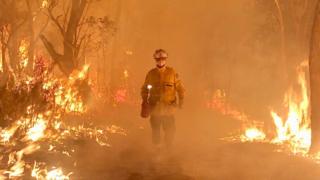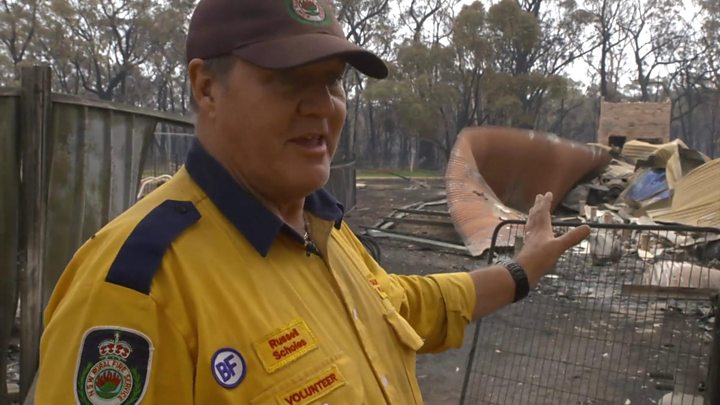 Image copyright
DANIEL KNOX/ANDREW O'DWYER
Image copyright
DANIEL KNOX/ANDREW O'DWYER
"We're doing it because it's a passion. It's a brotherhood," says Daniel Knox.
"When that photo was taken of me, I had done a 15-hour shift out there."
He is one of thousands of Australians who've dropped their ordinary lives to battle the nation's raging fire crisis.
For weeks, the 22-year-old landscaper has lived around his phone, springing into action when called upon.
He is part of the New South Wales Rural Fire Service (NSW RFS) which calls itself "the world's largest volunteer firefighting organisation". Its 70,000 members are extensively trained and, except for a few senior staff, mostly unpaid.
Mr Knox joined his local brigade in Sydney's south-west five years ago, when he was 17. He bonded with a senior member - Andrew O'Dwyer - over football and photography.
"He took me under his wing, looked after me and helped me out so much. The respect he gave me, a young bloke, even when I made mistakes... he was my brother," he told the BBC.
Last Thursday, Mr O'Dwyer and Geoffrey Keaton, the deputy captain at the Horsley Park Fire Brigade, were sent out late at night to a massive firefront.
En route their truck was hit by a falling tree, which caused it to roll. Three firefighters in the back seat were injured but were able to escape.
Mr O'Dwyer and Mr Keaton - both fathers to young children - were killed at the scene. They died five days before Christmas.
Earlier, bigger, more dangerous fires
Since September, close to 3,000 firefighters have been out every day in NSW battling blazes the size of small European countries.
Close to 90% of those people on the ground are unpaid volunteers, says the NSW RFS, the government-funded organisation leading the fight.
This century-old model is common across Victoria, South Australia, and Western Australia - Australian states which have traditionally had bushfires each summer. In recent years, fires have also flared up in Tasmania and sub-tropical Queensland.
In NSW, most of the 2,000 or so brigades are found in country towns and rural centres dotted among eucalyptus bushland. Members are almost always locals, stepping in to save their own communities.
Historically, the work has tended to be patchy, which has been a key factor behind the volunteerism. Fires don't rage all year round, and there have been years when many areas aren't affected at all.
But this year, the situation has changed. Intense blazes typically seen in later summer have flared in spring, forcing authorities to wage full-blown campaigns earlier than ever before.
They're also dealing with hundreds more fires, burning simultaneously in hotter and drier conditions. NSW has been in drought for years, and fires are ripping through the state.
The monstrous Gospers Mountain blaze, an hour's drive north-west of Sydney, has spread to more than 450,000 hectares in size in less than a month. Officials now consider it to be potentially one of the largest fires ever recorded in Australia.
'Everyone's working so hard'
For weeks, Lucy Baranowski has been among the crews fighting that blaze, and others closer to her home in Kurrajong Heights. She and her partner took leave from their day jobs a few weeks ago - and are currently skating by on savings, credit cards and support from family and friends.
She misses her children - she evacuated them to her parents' home over a week ago. On Saturday, her crew helped save a friend's property - a success. But then the wind changed, and the crew could only watch on as the blaze tore through the neighbouring village of Bilpin.
The situation is extreme, but she has been buoyed by the "bubble of love" from her community, she tells the BBC.
Her friends have organised her children's Christmas presents. Others have manned shifts cooking and cleaning for crews at the station. A prolific blogger, her latest posts about her fireground days have gone viral on social media.
"So many people aren't making an income but are putting every part of their passion and blood into this campaign - it's really, really rough on a lot of people," she says.
She describes the RFS as her family - and in her case this is a literal statement. Out on the fireground she's standing alongside her father and her younger brother, as well her friends, her neighbours, all of them communicating via radio.
They've been running on adrenalin, but the prospect of a drawn-out summer and a seemingly endless fire front is weighing on all of them.
"You can just hear the fatigue in their voices and almost imagine their dirty, sweaty, ash-covered faces," she says.
"Everyone's working so hard to keep everything together but there's no rain forecast, and there's really nothing we can do to stop this fire."
"Do we start to give up hope now that this isn't going to stop?"
News of the firefighters' deaths at Horsley Park, only a 40-minute drive away, "shattered my heart" she says.
"I didn't know them - but that could have been my husband, my father, my uncle, my friend," she said. "After all this is over, we're probably going to fall down in a heap."
'What am I doing here?'
The mammoth, ongoing task has spurred a national conversation about support for firefighters.

Media playback is unsupported on your device
The Labor opposition, town mayors, and a firefighters' union have called for them to be compensated.
"They volunteer as much as they can afford, sometimes even more than they can afford. It is not sustainable," says Mick Holton, president of the Volunteer Fire Fighters Association.
It often involves long hours, weeks away from paid work, and accruing expenses along the way. Earlier this year, Mr Knox travelled to the town of Tenterfield to help fight blazes there. It was an eight-hour drive from Sydney - he paid for his own petrol.
Public support for the "firies" is at an all-time high. In the swing of the Christmas season, shops and restaurants are donating profits to the NSW RFS. Online, there have been fundraisers to buy masks, food, and other supplies for the crews.
However, Australia's government has so far rejected the calls for compensation.
"Now is not the time to go into it. Let's get through this [bushfire crisis] first," said Prime Minister Scott Morrison on Monday.
A day later he announced the government, as a "model employer", would grant a minimum 20 days leave entitlement for public servants who went to the fires.
"When people join these organisations, they do it to protect their community and do it out of a sense of great service," he has said.
That sentiment is what you hear from many firefighters. They're not motivated by money. They're reticent to speak up for any sort of handout. They've also been consumed with fighting the fires.
"People don't get it, people think how do you risk your life and not get paid for this stuff?" Mr Knox says.
"And yeah, there have been times when I've been in the thick of it, and it's so fierce you can't breathe. And I'm thinking to myself, what am I doing here?"
"But when you're on the truck, you're with your brothers," he said.
He took care of Mr O'Dwyer's young daughter when the prime minister visited the station on Sunday, to meet with her grieving mother.
He's proud of the photo he shared last week, which was taken in a controlled setting. That image of him standing in the middle of a flaming forest has gone viral. Mr O'Dwyer had helped him put the finishing touches on the edit.
"Everyone has a choice in life, in what they want to do when they wake up in the morning," says Mr Knox.
"I'd rather be out there firefighting - doing our part for the community. Making those two boys proud of us for getting back out there."
